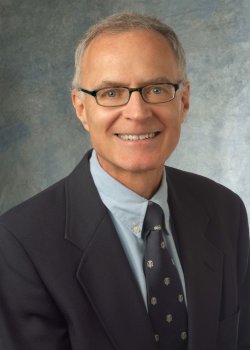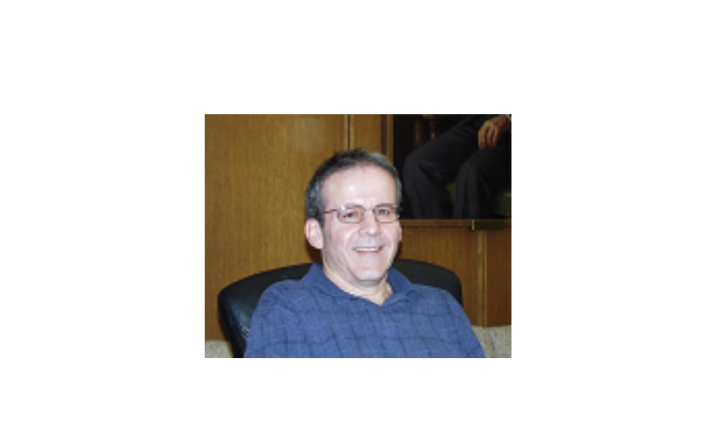
Christopher Tuma to retire June 1

After 34 years as the co-director at the Advanced Manufacturing and Mechanical Reliability Center, Christopher Tuma will retire on June 1.
Tuma is particularly proud of how much AMMRC has grown during his tenure. Shortly before his arrival, the cost center, then called the Mechanical Characterization Facility, had recently gotten new pieces of equipment and was undergoing renovation because of some large grants received. Tuma provided input on the renovation in addition to getting that equipment up and running, and he and Professor John Lewandowski, the AMMRC director, built the facility to what it is today.
When Tuma started in the Mechanical Characterization Facility in 1987, there were only about ten mechanical testing machines, mostly outdated and in need of computer integration and upgrades. Now, there are over twenty fully functional machines, some quite unique, with updated computers and software. The capabilities have expanded beyond conventional mechanical testing during his tenure, and now occupy White 211, 213 and 216 in the Charles White Metallurgy Building. In 1995, Lewandowski received a large NSF-MRI award to extend these capabilities into advanced deformation processing with the design and purchase of advanced metal forging and forming equipment. Tuma was instrumental in helping with the design and specifications of these unique rigs that reside in White 115, and that have been used on multiple government and industry funded projects on forging and forming of metal alloys, composites, and polymeric materials. These rigs and the inclusion of unique extrusion equipment, run by Rich Tomazin, provided unique breadth to the Mechanical Characterization Facility. Opportunities in advanced manufacturing continued to evolve and the center evolved into the Advanced Manufacturing and Mechanical Reliability Center (AMMRC) in the early 2000s to reflect the breadth and depth of manufacturing and mechanical reliability capabilities.
Tuma appreciates the variety of testing AMMRC does. “I can’t believe the testing I’ve been involved in here.” Shortly after he started, he began doing testing on rat skins. He has tested rabbit bones, dental implants, breast implants, implantable wires, ceramics, plastics and glass, including glass used for the cover of cell phones. He had also tested the graphite paper used in cell phones. “You come to work and never know what you’re running into next.”
"Chris has some funny stories about the variety of materials he tested in AMMRC over the years,” said Benjamin Palmer, who graduated from CWRU with his PhD in May 2020. “These ranged from cow tendons and human hair to Gorilla glass, like that in many screen protectors. The one that most stood out was when he was running seat-cushion testing using a simulated human posterior - lovingly referred to as the ‘keister tester!'”
Tuma has also enjoyed studying fatigue and fatigue crack growth.
In the late 2000s, Lewandowski and Professor Joe Payer became more closely involved with the CWRU-FES center and the reliability of implantable FES components. Tuma played an instrumental role in helping to design experiments to evaluate the mechanical reliability of the implantable wires/cables as well as connections.
Lewandowski described Tuma as having an “excellent professional attitude and ability to interface with a culturally and disciplinary diverse range of students, staff, faculty, and external collaborators” and a “depth and breadth of experience in mechanical characterization.”
Prior to coming to CWRU, Tuma spent ten years working at Republic Steel Research before going to Timken Research. At both places, he primarily partook in steel testing. At Timken, a coworker told him about the position at CWRU opening up. Tuma was interested because he liked the idea of working at an educational institution and thought there would be a big variety of testing, whereas at Timken and Republic, testing was more limited. “Here, there’s no such thing as a standard sample because there are so many different types of samples,” said Tuma. “You never know what you’re going to get here even when you’re testing materials. In the research field there, it was geared toward specific products, whereas here, research is everywhere.” Tuma has done testing for Timken while in AMMRC, as well as numerous other local and national corporations.
Tuma’s other responsibilities include training graduate students on various equipment, maintaining equipment and sending time reports for the usage of the equipment to Lewandowski every month. He has worked very closely with over 150 graduate students, postdoc scholars and visiting scholars in Lewandowski’s research group over the years, representing a diverse group from around the world. In addition, he has helped numerous other students from across CWRU as the AMMRC is a campus core facility. According to Lewandowski, “Our government and industrial sponsors have appreciated the care and expertise provided by the AMMRC as reflected in their continued and growing research funding breadth and depth. Chris has impacted this very positively over his decades at CWRU, and we are in the process of submitting some very large collaborative proposals as a result of this history. I have also been very impressed by his ability to continue and extend our efforts in the face of the COVID-19 pandemic. Undergraduate and graduate student projects have continued to make excellent progress in a safe manner, in large part due to his efforts and effective interactions with others.”
In addition to his scientific work, Tuma values the relationships he’s built during his time at CWRU. He said that he “couldn’t ask for a better supervisor” than Lewandowski, who he has run several 5K races with. (Lewandowski pointed out that Tuma “used to let me beat him in the 5K.”) He also enjoyed bonding with students during the happy hours the Department of Materials Science and Engineering held on Fridays prior to the COVID-19 pandemic, during which they would frequently play card games or poker.
After he retires, Tuma will head to The Villages, Florida, which he describes as “its own little city in the middle of nowhere.” A self-described “fitness fanatic” who enjoys running, biking and yoga, he recently got his personal trainer certification with an added senior fitness specialty. He hopes to help others in the 55 and over community that he will be living in to maintain an active lifestyle. He also looks forward to being close to beaches, including Daytona Beach and St. Petersburg, and to Disney World, the latter of which his seven grandchildren are particularly excited about. “The first thing they asked when we told them they were moving to Florida was if we would be close to Disney.”
"We will miss him and hope to be able to keep in contact while he enjoys retirement,” Lewandowski said of Tuma.
